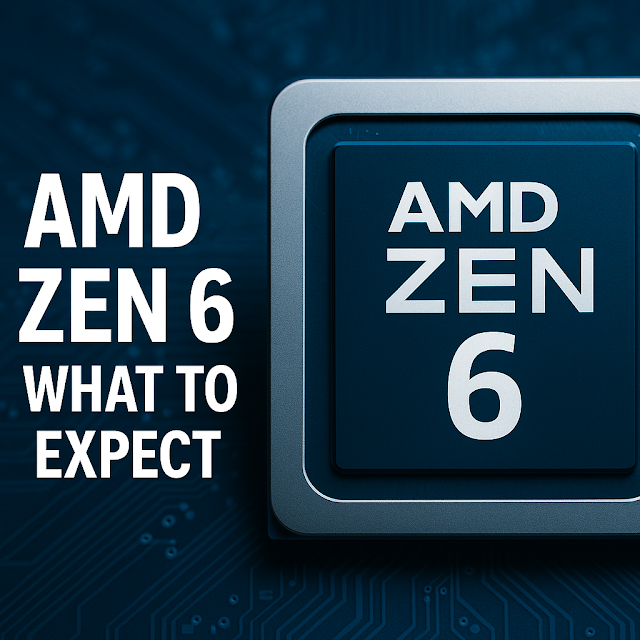AMD Zen 6: 15 Groundbreaking Features to Expect from Ryzen’s Next-Gen Architectur
Thursday, July 17, 2025AMD Zen 6: 15 Groundbreaking Features to Expect from Ryzen’s Next-Gen Architecture
AMD Zen 6 could be AMD's boldest architecture yet. With a rumored 2nm node, IPC gains, new cache hierarchy, and integrated AI features, here’s everything we know so far about Zen 6’s release and specs.
Table of Contents
- Introduction to AMD Zen 6 Architecture
- Expected Release Timeline & Code Names
- Key Differences Between Zen 5 and Zen 6
- Process Node and Manufacturing Advances
- IPC and Single-Core Boosts
- AI & Machine Learning Enhancements
- Cache Architecture Changes
- Memory Support and Bandwidth
- I/O and PCIe Enhancements
- Power Efficiency & Thermal Design
- Desktop vs Mobile Variants
- Integration with RDNA and Accelerated Compute
- Server Innovations (EPYC Zen 6)
- Competition: Zen 6 vs Intel Nova Lake
- Potential Roadblocks and Delays
- Conclusion: Is Zen 6 AMD’s Boldest Leap Yet?
- FAQs About AMD Zen 6
Introduction to AMD Zen 6 Architecture
Zen 6 is AMD's upcoming CPU microarchitecture, expected to succeed Zen 5 as the backbone of future Ryzen, EPYC, and APU chips. It promises sweeping enhancements in instructions-per-cycle (IPC), power efficiency, AI acceleration, and interconnect speed—designed to dominate everything from gaming desktops to cloud data centers.
Expected Release Timeline & Code Names
- Launch: Late 2025 or early 2026.
- Code Names: Morpheus, Nirvana, and Halo depending on product segment.
Key Differences Between Zen 5 and Zen 6
Zen 6 will introduce updated instruction sets, better branch prediction, and deeper pipelines. Early estimates point to up to 30% performance-per-watt improvements over Zen 5.
Process Node and Manufacturing Advances
Zen 6 is likely to be built on TSMC’s 3nm or 2nm (N2) process node, resulting in reduced power leakage, smaller chiplets, and improved yield for high-core-count parts.
IPC and Single-Core Boosts
Predicted IPC improvements range from 10% to 20%. This makes Zen 6 a significant upgrade for both gamers and professionals who rely on single-threaded performance.
AI & Machine Learning Enhancements
Zen 6 is expected to include native AI co-processors or matrix acceleration engines that will support FP16 and INT8 workloads, enabling fast local inference and generative tasks.
Cache Architecture Changes
Potential changes include:
- Rebalanced L1 and L2 sizes for lower latency
- Expansion of L3 and possible L4 cache
- Continued use of 3D V-Cache for select SKUs
Memory Support and Bandwidth
Expect support for:
- DDR5 and LPDDR5X
- Future DDR6 readiness
- Improved Infinity Fabric memory latency
I/O and PCIe Enhancements
- PCIe Gen 6 in server/enthusiast SKUs
- USB 4.0 or USB 4.2 support
- Lower latency for NVMe storage and GPU communication
Power Efficiency & Thermal Design
Zen 6 will improve Dynamic Voltage & Frequency Scaling (DVFS), smart boost logic, and mobile thermal management, maximizing both performance and battery life.
Desktop vs Mobile Variants
- Desktop: Likely to continue AM5, but some high-end may debut AM6.
- Mobile: Integrated RDNA 4/5 graphics, LPDDR5X support, and lower TDPs for ultra-thin laptops.
Integration with RDNA and Accelerated Compute
In APU form, Zen 6 may integrate RDNA 4 or 5 with unified cache access and AI-aware compute pipelines—ideal for gaming handhelds and multimedia creation laptops.
Server Innovations (EPYC Zen 6)
- Over 128 cores per socket
- Wider memory bus and more channels
- Optimized for hyperscale and AI/ML workloads
Competition: Zen 6 vs Intel Nova Lake
| Feature | AMD Zen 6 | Intel Nova Lake |
|---|---|---|
| Process | 3nm / 2nm | N2 / 18A |
| AI Support | Native matrix units | Discrete accelerators |
| Cache | L3 + V-Cache, possible L4 | Modular cache tiles |
| iGPU | RDNA 4/5 | Xe3P |
| Efficiency | DVFS + N2 gains | Hybrid cores + Foveros |
Potential Roadblocks and Delays
- Manufacturing complexity at 2nm
- Socket and BIOS compatibility challenges
- Global fab or supply chain disruptions
Conclusion: Is Zen 6 AMD’s Boldest Leap Yet?
With AI, efficiency, scalability, and IPC all improving, Zen 6 may become AMD’s most important release yet. It aims to push boundaries across every sector: desktop, mobile, and server.
FAQs About AMD Zen 6
Q1. When will AMD Zen 6 launch?
Expected in late 2025 or early 2026.
Q2. Will Zen 6 use AM5?
Yes, though some high-end variants may shift to AM6.
Q3. Will Zen 6 improve gaming?
Yes, with improved IPC and cache access speed, it should boost single-threaded game performance.
Q4. Will it have AI support?
Zen 6 will likely feature dedicated AI instructions and matrix engines.
Q5. Can Zen 6 outperform Intel Nova Lake?
It depends on workload, but Zen 6 will likely lead in IPC and efficiency, while Nova Lake emphasizes integrated GPU and modularity.

